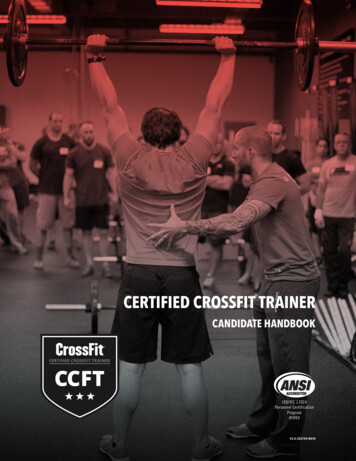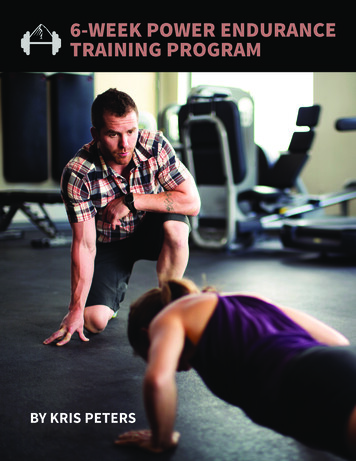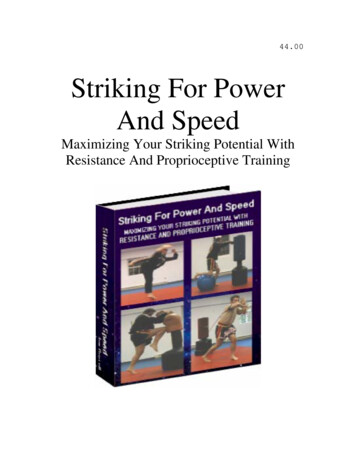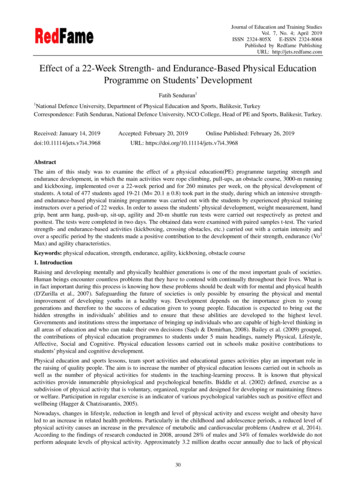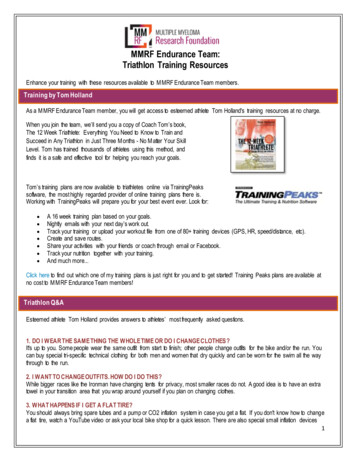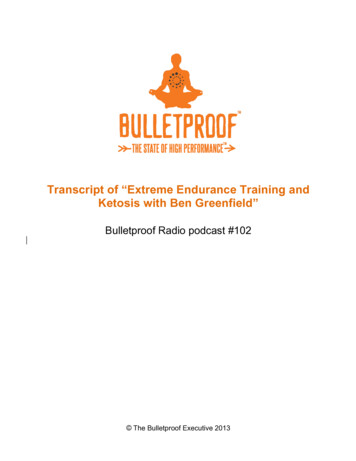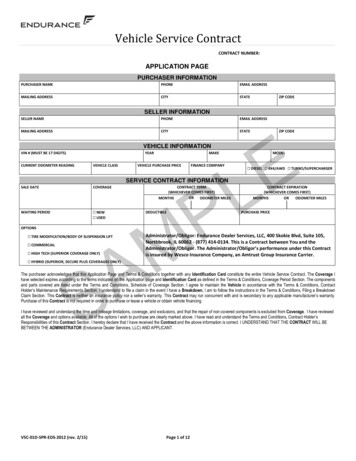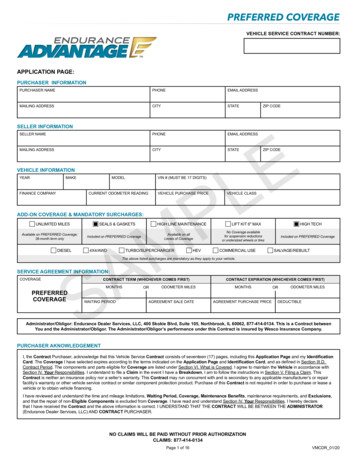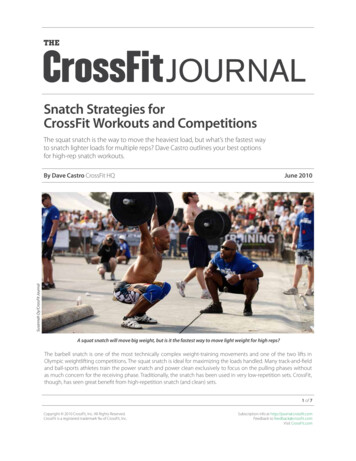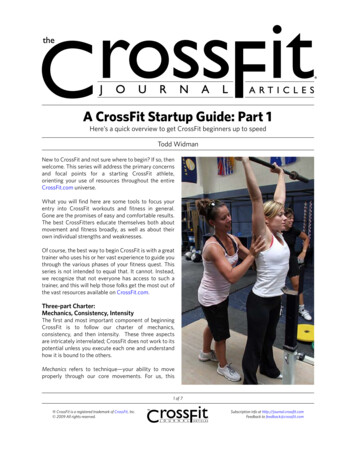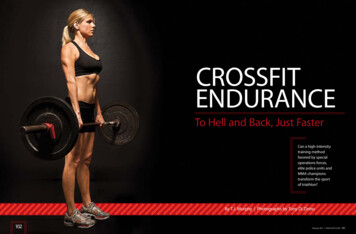
Transcription
CrossfitEnduranceTo Hell and Back, Just FasterCan a high-intensitytraining methodfavored by specialoperations forces,elite police units andMMA championstransform the sportof triathlon?By T.J. Murphy Photographs by Tony Di Zinno102February 2011 triathlete.com103
Athlete imageswere captured atCrossfit LA inSanta Monica,Calif.The Crossfit-basedplan for endurancesports hingeson low-volume,high-intensitytraining designedto constantly shockthe body.104OnJune 18 last summer,Guy Petruzelli, a 37-year-old professionaltriathlete from Westmont, Ill., was ridinghis bike when he was hit by a car. He suffered multiple fractures to his collarboneand three broken ribs. Ten days later hewas told his season was over, and thenthe surgeon drilled seven screws and aplate into his breastbone. Said the doctorto Petruzelli, “I don’t think you’ll be ableto train hard until December.”Pity the doctor issuing orders to a driventriathlete—the surgeon’s words had theimpact of elevator music. Virtually his nextstop after post-op was a gym on the westside of Chicago, a Crossfit gym, Crossfitbeing an aggressive approach to fitnessthat in the last decade has stormed acrossthe country with cultish fervor.“I went to see my guys at Crossfit, NateAye and John Conquest, and my coach, JenGarrison,” Petruzelli says. “I told them Iwanted to do two things: First, get healthyfaster than my doctor’s projections, andsecond, get stronger and faster at thesame time.”The Crossfit team started him off withsimple, non-jarring lower body movementsand agility moves. Two weeks later he wascleared to ride an indoor bike. Petruzellisays he was stunned to notice that not onlyhad he lost no fitness, but his power intervals showed an upward spike. Impressedwith the effect, he immersed himself inlearning about the Crossfit-based plan forendurance sports, a philosophy that hingeson low-volume, high-intensity trainingdesigned to constantly shock the body.“I’m an old-school endurance guy,” saysPetruzelli. “I was skeptical, but I committedmyself to doing everything exactly as it waswritten.” A few weeks after he was clearedto begin running again in August, Petruzelliperformed a session of mile repeats at5:15 pace. He was faster than before theaccident. “And my lactate threshold onthe bike was up 33 percent. It was insane.I asked, ‘How the hell is this happening?’”On Oct. 24 he raced an Olympic-distancetriathlon and recorded the fastest split onthe 10K run course, 31:48. “I haven’t runFebruary 2011 triathlete.com105
The Crossfit movementlooks one part NavySEAL training, one partpost-grad exercisephysiology and one partvast social network,all with a heavy metalsoundtrack.106like that since college,” he says. He hasdecided to train the Crossfit way for theentirety of 2011.Brittany Rutter, a 34-year-old agegrouper and USAT-certified coach had asimilar surprise using Crossfit. From Seabright, N.J., Rutter, a longtime coach andpersonal trainer, had been frustrated foryears trying to get back to a 2003 IronmanLake Placid PR of 11:33 despite multipleattempts. “I wasn’t getting any faster,”she says. “I wasn’t having any fun. I wasn’tready to give up but I knew I needed to dosomething different.” Rutter went to aCrossfit Endurance certification and despiteher skepticism—she would be trading infive-hour bike rides and two-hour runs fortime trials, intervals and high-intensitygym sessions—she followed the programto the letter almost as if to prove it waswrong. “I thought, ‘This is going to be thebiggest waste of my time.’”There were no 60-minute recoveryruns or easy spins. “Recovery was sleep,”she says. The training was shockingly intense—she had one interval workout thatconsisted of five one-mile repeats, eachmile an all-out effort—and at times isolating. “I have five friends that were trainingfor [Ironman] Lake Placid. I was the onlyone doing Crossfit,” she says. “They’d goout on their five-hour bike ride and I’d gooff on my 30-mile time trial. They’d teaseme later with text messages: ‘Are you taking a nap yet?’ They didn’t get it.”Despite the lower volume, Rutter burnedoff six pounds. “I was eating more thanever. And my physical therapist asked me,‘Do you know how much better off youare?’ My hips were looser and my iliotibialband was healthy.” At Ironman Lake Placidshe finished in less than 12 hours and PR’dher run. She also saw that three Crossfitathletes doing their first Ironman, one amother of three in her late 40s, all recordingimpressive times. Rutter is now preachingthe gospel admitting, “I can’t return to theold ways I used to coach.”The MovementI first heard about Crossfit two years agowhen I watched from an L.A. Fitness treadmill as a personal trainer hammered aclient through a relentless form of circuittraining. The trainer was 5-foot-2 with agymnast’s body, shrink-wrapped in blackLycra, impatiently leaping and bounding around her client, issuing commands,correcting form and coaching with theintent of an air traffic controller. The clientwas heaving for air and his eyes spun likepinwheels. She had him rotate furiouslybetween sets of medicine ball throws,squat jumps and presses with dumbbells.I figured I was maintaining a heart rate of135. He looked to be jamming up against200. I talked to the trainer and she toldme about Crossfit. Later that day I pokedaround Crossfit.com and was introducedto a fitness movement that looked likeit was one part Navy SEAL training, onepart post-grad exercise physiology andone part a vast social network, all with aheavy metal soundtrack.In reading about Crossfit, you’ll notethe founders still seem peeved that a 1997issue of Outside magazine ran a photo ofsix-time Ironman champion Mark Allenon the cover and labeled him the fittestman alive. “For Crossfit the specter ofchampioning a fitness program withoutclearly defining what it is that the programdelivers combines elements of both fraudand farce,” the Crossfit Journal stated in2002. “Our incredulity on learning of Outside’s awarding a triathlete title of ‘fittestman on earth’ becomes apparent in lightof Crossfit’s standards for assessing anddefining fitness.” The October 2002 issuethen lays out a lengthy definition including three standards of fitness, 10 generalphysical skills, skill mastery and the thorough development of three “metabolicengines”—the phosphagen system forhigh-powered work, the glycolytic systemfor medium-powered and the oxidativesystem for low-powered. More specifically,the phosphagen system is the adenisineFebruary 2011 triathlete.com107
Brittany Rutter’sironman TrainingLog, Pre-CrossfitEnduranceMonday: One-hour run with 3x1-milerepeats using four-minute recoveriesTuesday: One-hour swim (main set:2x600 meters)Wednesday: One-hour bike (include18x30 seconds hard effort, 30 secondseasy effort; hold remainder at 80 percentmax effort) with 30-minute run off thebikeThursday: 2.5-hour runFriday: One-hour swim including 2x800meters; 45-minute runSaturday: 4.5-hour bike with intervalsSunday: Three hours on the bike with2:20 at 80 percent to 85 percent intensityfollowed immediately by 30-minute run. and after adoptingcrossfit Endurancetrainingtriphosphate (ATP) energy system thatis the most readily available source ofenergy in the muscles.Crossfit’s accelerating popularity hasspawned gyms throughout the country,with 2,300 affiliates and a website thatattracts 4 million visitors per monthdespite incendiary buzz that surroundsit. A story on Crossfit in the New YorkTimes was headlined, “Getting Fit, Even ifIt Kills You.” Outside reported a description of a Crossfit splinter movement ashaving fitness routines “said to be sointense, so blindingly debilitating, thatthey brought even the hardest men totheir knees, whimpering in slicks of theirown sweat.” Veteran Crossfitters areknown to refer to their fabled mascot,Pukie the Clown, when they ask newbies,“Have you met Pukie yet?”Quality, Not QuantityAn hour sifting through the Crossfitwebsite can inspire awe. There’s a heavyconnection with the military, elite policeunits, a survival-of-the-fittest ideologyand a bank of expletive-inspiring WODvideos, WOD standing for “workout ofthe day.” WODs are commonly referred108triathlete.com February 2011to as the “girls”: circuits with names likeFran, Heavy Fran, Grace and Helen. Oneof the more famous WOD videos—namedNasty Girls—is a tape of three womenin super hero-like condition performing three circuits of a combination ofsquats, muscle-ups performed on gymnastics rings and power cleans withbarbells, with no rest. By the end of thefirst set the intensity is acutely visibleas the women try to shake fatigue outof their arms. By the last circuit one ofthe Crossfitters battles to complete themuscle-ups, faltering several times,yet, astoundingly, persists through theremaining reps. The final set of powercleans looks ready to crumple her butshe finishes with an emotional flourish,tears flying.Crossfit Endurance has been gaininginterest as an approach to training fortriathlon. Founded by Brian MacKenzie,a powerlifter and strength coach wholeaped into triathlon in 2000, CrossfitEndurance was launched in late 2007after MacKenzie spent two years experimenting with making Crossfit the foundation of his preparation for 100-mileultra-runs. In his blog called “Unscared,”Iamunscared.com, MacKenzie reportedRutter’s boot camp classes used pull-upbars, dumbbells, kettle bells, jumpropes and boxes for jumping using verytraditional movements.Monday: 5x1-mile runs, each rep all-out,with eight minutes recovery; three hourslater taught boot camp workout forCrossfit WODTuesday: Bike 32 repetitions with20 seconds hard and 10 seconds easy,recording total of accumulated distance;Crossfit WOD of 5x3 max deadliftsWednesday: 400-meter swim time trialThursday: Bike intervals; taught bootcamp workout for Crossfit WODFriday: Swim main set: 8x100 metersfreestyle hard with three-minuterecoveries; Crossfit WOD 7x1 max weightdeadliftsSaturday: 13.1-mile time trial run; Crossfitstrength WOD that included box jumps,kettle bell swings and pull-ups, all fortime, three circuits total and time noted.Sunday: 20-mile time trial bike ride(This week was executed eight weeksout from Ironman Lake Placid, coachedby Max Wunderlie.)
that he placed 34th out of 125 runners atthe Angeles Crest 100 after training only6.5 hours per week. “My biggest week ofrunning was 36 miles,” he wrote.In supplanting high volume for highintensity MacKenzie relied on a 2006 McMaster University study published in theJournal of Exercise Physiology that comparedthe training effect of short-term sprintintervals versus traditional bouts of long,slower distance workouts. The conclusion stated, “these data demonstrate that110triathlete.com February 2011sprint-interval training is a time-efficientstrategy to induce rapid adaptations” andexercise performance “comparable toendurance training.”MacKenzie says the results he’s beenseeing consistently have him believingthat Crossfit Endurance is a game-changerand will eventually overhaul the approachof anyone serious about endurance performance. “What I’m saying is quality,quality, quality, with constant variance.What we’re seeing across the board isimproved performance with one-thirdof the volume.”Blazing the TrailTwo different categories of WODs comprisethe Crossfit Endurance program: strengthand conditioning WODs and sport-specificWODs. The Crossfit Endurance website,Crossfitendurance.com, posts the workoutseach day. Traditional recovery sessions,such as an easy bike spin or jog, are slashed
from the calendar. The always-varyingstrength WODs are typically short, highintensity bouts of 20 minutes or less. Thesport-specific work is usually something likea time trial or interval session. The sessionsare brief and taxing. As Southern California Crossfit trainer Nuno Costa tells me,“Always be wary when a Crossfit trainertells you, ‘It’s only 12 minutes,’” meaningthat 12 minutes at maximum effort canseem like a long, long time.Will MacKenzie’s prediction prevail—that a training movement using Mark Allen as an example of what’s wrong withtriathletes will transform the sport? Classicendurance training remains rooted in thephilosophy of the late running coach ArthurLydiard, in which you build a base usingmonths of aerobic training, then moveinto a strength phase and then, nearinga championship, use speed training andracing to hit a peak.Crossfit Endurance is radically different.MacKenzie says there is no base phase,that the best way to train for an endurance event is to constantly be trainingall energy systems with variety, power,speed and skill.Conventional wisdom says no way, butin recent years the endurance world hasbeen moving in this direction. Jay Johnson,a University of Colorado running coachwho produces strength-training videos forRunningDVDs.com, says that enduranceathletes need the strength work.“Endurance activities are basically catabolic—they break you down—and generalstrength is anabolic—it builds you up.Endurance athletes need some anabolicactivities in their training week to offsetall the catabolic time spent running, bikingand swimming.”“I’ve been watching the forum boardsshift into being more open-minded aboutCrossfit,” MacKenzie says. “At first I wasthe antichrist. But now it’s becoming moreacceptable.”Triathlon was a sport blazed by pioneers.If Crossfit Endurance becomes popular itwill be because the likes of Petruzelli andRutter found success in blazing the trail.112triathlete.com February 2011Getting StartedTips for smooth entry into the world of Crossfit Endurance1.Don’t be intimidated. “Everyone thereis there to support everyone else,” GuyPetruzelli says. “It’s a very positive atmosphere.” Brittany Rutter agrees: “The truthis that Crossfit has a culture like triathlon.Reach out for help. The community isincredibly open and supportive.”2.Visit the Crossfit Endurancewebsite (Crossfitendurance.com).“Crossfit is growing at a fast pace, andthere are going to be a few gyms outthere that are out there
crossfit ndurance has been gaining e interest as an approach to training for triathlon. Founded by Brian macKenzie, a powerlifter and strength coach who leaped into triathlon in 2000, crossfit endurance was launched in late 2007 after macKenzie spent two years experi-menting with making crossfit the foun-dation of his preparation for 100-mile
